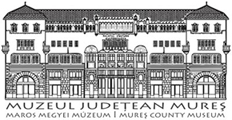Marisia - Maros Megyei Múzeum Évkönyve 33/4. (2013)
Articles
Akinakai of Kelermes Type: New Discoveries in Central Bessarabia 19 a similar dagger was found (PL 6/5).m Among the swords grouped by A. Vulpe into Ferigile-Läceni type, two exemplars of Läceni variant should be mentioned, e.g. eponymous stray-find from Läceni101 102 (Pl. 6/9) and a sword from burial mound 41 from Ferigile103 (PL 6/4). The swords of Ferigile variant do not show so obvious similarity, though the exemplar from Curtea de Arge§ (Pi. 6/11) has triform handle and its pommel is decorated with horizontal lines.104 A snaffle of Vekerzug type with endings in shape of horse heads (4th variant after Kemenczei) was also found with that sword. Terminus post quern for snaffles of this type is last decades of 7th c. BC105 though in Carpathian basin this type penetrates at the turn of 7th-6th c. BC.106 And the burial 41 from Ferigile an Curtea de Arge§ burial A. Vulpe grouped into Ferigile-4 stage, 1st half of 6lh c. BC,107 allthought later he dated the 4th stage by entire 6th c. BC, and the t.p.q. was determined as ‘late 7th c. BC’.108 To the South from Danube, a well-preserved akinakes found near Praventsy, Bulgaria is stored in Museum of Shumen109 (PL 5/17), and it is very close to the sword from Kiev-Vetrjannye Gory by design. The geographical distribution of akinakai of Kelermes type is a quite interesting phenomenon, these finds practically do not overstep the bounds of forest-steppe area of Scythian culture (PL 2). Furthermore, there are at least two directions of their spread: a meridional one for graves and latitudinal (both East and West) for stray finds. So, it seems those researchers who believe that the process of typological formation of Scythian akinakes was initiated on Northern Caucasus based on Kabardino-Pyatigorsk type of daggers110 are closer to the truth than others. However we could not ignore the role of Transcaucasia, where Scythian weaponry either was imported directly or was produced basing on northern Caucasian samples,111 and not later than middle 7th c. BC, i.e. almost simultaneously with appearance of prestige forms of akinakai of Kelermes type. As for the high number of strayfinds from forest-steppe regions (e. g. Don region), 101 Vulpe 1987, 179, fig. 2/2; 1990, Taf. 4/17. 102 Vulpe 1990, 31-32, Taf. 4/14. 103 Vulpe 1967, 131, pl. XV/2; Vulpe 1990, 32, Taf. 4/15. 104 Vulpe 1967, pl. XVI/1; Vulpe 1990, 31, Taf. 2/13. 105 Kemenczei 2009, 51. 106 Brujako 2005, 273. 107 Vulpe 1977,91. 108 Vulpe 1990, 125-126. 109 Atanasov 1995. 110 Leskov 1979; Cernenko 1979; Shramko 1984; Ismagilov 1989. 111 Esajan - Pogrebova 1985, 52. their concentration causes various discussions and versions, for example, of their using in cult purposes, ‘sacrificial or memorial cult processed even on battlefields’112 or about their connection with destroyed burial complexes.113 On the other hand, the steppes of Don are not the single region where the stray finds concentrate. So, the stray finds of Scythian swords and daggers represent about 75% of the finds in Carpathian- Dniester or not less than 50% in middle Dniepr region.114 Among other things, the concentration of stray finds of Scythian weaponry to East from Carpathians (e. g. on Bärlad Plateau as well as between the Bistri|a and Tärnäu ridges) is definetely connected with Scythian migrations from Moldova to Transylvania.115 There is an extremely important discovery from Lower Danube, related to the problems of Kelermes type - an unique bronze model of akinakes, found in 1955 near Medgidia, Romania.116 This item has been moulded from high quality bronze and richly decorated with reliefs and carved ornamentation on one side, and with two shafts for attachment on another (PL 6/1). D. Berciu suggested that this find is an emblem’ for decorating the burial chamber or, more likely, is an element of Scythian anthropomorphic sculptures,117 which are well-known in Romanian part of Dobruja from 6lh c. BC.118 The lack of analogies for this item, as well as traces of use do not allow the clear determination of its function. But it is needed to note that the akinakes is one of the most popular elements of Scythian sculpture and could be met on more than 40% of findings.119 Besides that, on the one of Scythian statues from Lower Danube there are made several hollows below the line which could be used for attachment120 of such kind of ‘emblem’.121 Regarding the time of producing this model, it seems important to solve the problem what kind (or what type) of akinakes it presents. Such features as parallel edges of the blade, the 112 Sarapulkina 2005, 162; Voroshilov 2011, 166-167. 113 Razuvaev - Kur’janov 2004, 192. 114 Topal 2005, 29. 115 Especially big concentration is situated near Tärgu Neamp not far from the existing now mountain passes as Paltini?, Tulghez and Bicaz. Mihailescu-Birliba - Untaru 1971, fig. 4. 1,6 Berciu 1958, 94-102, fig. 1-2; Berciu 1959,9-18, pl. I-II. 117 Berciu 1959, 18. 118 Ol’hovskij - Evdokimov 1994, 16. 119 Ol’hovskij - Evdokimov 1994, tab. 15; Topal 2005, 29. 120 The distance between these deepenings is close to the distance between shafts on the Medgidia model and is about 20 cm. 121 Alexandrescu 1958, 292, fig. 3-4.
